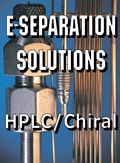Ask the Editor: Advantages of Supercritical Fluid Chromatography (SFC) for Preparative Separations
The major advantages of preparative supercritical fluid chromatography (SFC) include separation speed; the ability to achieve chiral separations; lower viscosity of the mobile phases, which allows high flow rates with acceptable pressure drops and results in higher productivity; reduction of solvent use of as much as 90% compared with liquid chromatography; and ease of processing collected sample fractions.
A reader recently asked:
What are the major advantages of using supercritical fluid chroamtography for preparative separations?
The major advantages of preparative supercritical fluid chromatography (SFC) include separation speed; the ability to achieve chiral separations; lower viscosity of the mobile phases, which allows high flow rates with acceptable pressure drops and results in higher productivity; reduction of solvent use of as much as 90% compared with liquid chromatography; and ease of processing collected sample fractions.
The "green chemistry" aspects and other advantages of the technique were discussed by Christopher Welch and colleagues in an installment of LCGC's "Column Watch" column (1). Preparative SFC equipment is manufactured by companies such as Jasco (Easton, Maryland), Mettler-Toledo (Columbus, Ohio), Novasep (Boothwyn, Pennsylvania), and Thar Technologies (Pittsburgh, Pennsylvania). </p>
(1) C.J. Welch et al., LCGC 23(1), 16 (2005).
Any Questions?LCGC technical editor Steve Brown will answer your technical questions. Each month, one question will be selected to appear in this space, so we welcome your submissions. Please send all questions to the attention of "Ask the Editor" at lcgcedit@lcgcmag.com. We look forward to hearing from you.
Study Explores Thin-Film Extraction of Biogenic Amines via HPLC-MS/MS
March 27th 2025Scientists from Tabriz University and the University of Tabriz explored cellulose acetate-UiO-66-COOH as an affordable coating sorbent for thin film extraction of biogenic amines from cheese and alcohol-free beverages using HPLC-MS/MS.
Multi-Step Preparative LC–MS Workflow for Peptide Purification
March 21st 2025This article introduces a multi-step preparative purification workflow for synthetic peptides using liquid chromatography–mass spectrometry (LC–MS). The process involves optimizing separation conditions, scaling-up, fractionating, and confirming purity and recovery, using a single LC–MS system. High purity and recovery rates for synthetic peptides such as parathormone (PTH) are achieved. The method allows efficient purification and accurate confirmation of peptide synthesis and is suitable for handling complex preparative purification tasks.



